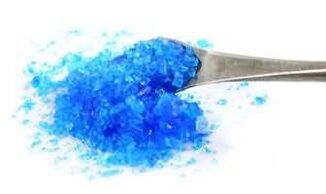Iodine protects nail health
Don’t forget that iodine is a very reactive substance and can cause some harm, such as chemical burns, etc. if not handled properly.
Safety rules when using iodine
- Treating the skin with iodine solutions can cause irritation and allergic reactions.
reaction. Therefore, before you start using it, apply iodine solution to the crook of your elbow and check the skin's reaction. - Frequent use of iodine solution can give nails an intense yellow color that cannot be removed until new nails grow.
- Chemical burns or inflammatory skin damage (dermatitis) may occur if used incorrectly or in excess of permitted doses.
- Only the affected nail and skin areas should be treated, and only during the main symptomatic stage.
Recipes based on iodine solution
- Recipe 1. For convenience, apply drops of an alcoholic solution of iodine (5%) to each affected nail twice daily in the morning and before bed. To prevent this disease and further build strength, the same solution (but in a smaller dose) can be lubricated onto healthy nail plates.
- Recipe 2. The six-week course of treatment is divided into three phases of fourteen days each. During this procedure, infected areas of the skin and nails are treated alternately: in the first two weeks with Castellani solution, in the second stage with iodine solution, and in the last two weeks with vinegar solution (9%).
- Recipe 3. First prepare a solution with the following ingredients: iodine, chloronitrophenol, vinegar essence, garlic juice, equal parts, one teaspoon of each ingredient. This solution should be used to treat infected nails every day before going to bed. Nails should first be steamed and the softened parts removed. The drug mixture must be shaken well before use.
When treating nails with any manicure accessory, you should remember: in order to avoid infection of healthy nails, separate tools should be used to treat the affected areas.
Copper sulfate treatment

- copper sulfate solution. Can be done at home. Dissolve one teaspoon of copper sulfate crystals in 1 liter of boiling water. The resulting solution is very concentrated, so it should be handled in dilute form: 1 tbsp. Lake solution per 1. 5 liters of water. To use this solution, soak your feet for ten minutes and then treat the affected areas of skin and nails with medications recommended by your doctor.
- copper sulfate ointment. Copper sulfate crystals are calcined on a hot surface until the color changes to gray or white. Then mix it with the other ingredients: a teaspoon each of yellow sulfur, tar or goose fat. The resulting ointment is used daily to treat sore nails until full recovery.
Sea salt and table salt for treating fungal infections

Salt itself does not cure fungi, but it is often used as a component of ointments and mixtures based on folk recipes.
Unusual uses for regular soda
- Recipe 1. Daily baths with soap and soda help the medicinal ingredients contained in the medicine to penetrate better directly into the affected area. This is often difficult because the affected nail is very thick, grows quickly and blocks penetration, while soap and soda can soften the nail plate. Mix 3 cups club soda and 3 Tbsp. Lake grated soap, then dissolve the resulting mixture in 7-10 liters of water. Keep your feet in the air for 20 minutes every day for 4-5 days.
- Recipe 2. Dilute a certain amount of soda with water into a paste and use it to cover the infected nail. After applying the soda paste to your nails for a few minutes, add a little lemon juice. The mixture is then removed, the nails are washed with soap and treated with an antifungal agent. This drug is also used only as companion therapy.
Using birch tar treatment process
Using tar soap can be used to prevent any skin disease as it contains up to 12% pure tar and has antiseptic properties. You should choose handmade tar soap, the usefulness of its ingredients is unquestionable.
Chelidonium cleanses skin
- celandine juice. Chelidonium juice is used to treat diseased surfaces of the skin and nails. Mix freshly squeezed juice with alcohol (70%) in a 1: 1 ratio and infuse within the next 24 hours. The treatment process takes about a week and is performed regularly on the pre-prepared nails and feet 3-4 times a day.
- Celandine infusion. Add 100 g of dried celandine leaves to 1 liter of boiling water. After half an hour, add the resulting infusion to the foot bath and steam your feet for 20 minutes every day.
- ointment. Chelidonium is part of a medicinal herbal ointment used to fight fungal infections. Add 5 drops of fresh celandine juice, 2 drops of oregano and 2 drops of prepared calendula tincture to cooled boiling water (4 tablespoons). Treatment with this ointment takes about 10 days, but the damaged area should be treated at least 3 times a day.
- Celandine oil. You can use celandine oil, available in any drug store, or you can make your own at home, although the process is quite laborious.

It is best to treat onychomycosis by combining folk remedies with traditional medicines - the effect will be stronger, and the treatment time for complete recovery will be significantly shortened.
















